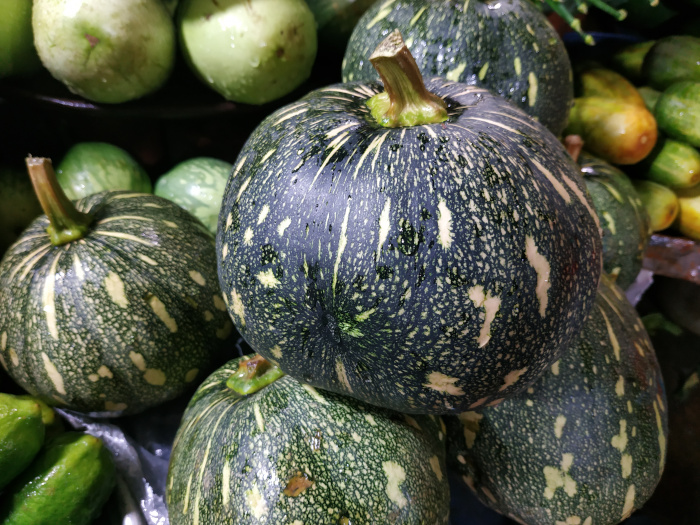Of all the winter squash, buttercup squash perhaps is the one most prized for its delicious flavor. It may not be much to look at, though some would argue that its rotund shape and the turbaned cap has its own charm. But let’s leave the pageants for the more hip butternut squash and the quirk factor to spaghetti squash. What you get with the buttercup is a solid bang for the buck. A dense and sweet flesh that’s perfect for the beginner to the squash world and an old friend of the veteran pro.
What Is a Buttercup Squash?
Buttercup squash is a type of winter squash, typically available throughout fall and winter. As it ripens, the cap starts to look almost like a turban, so that some of the buttercup squashes look like they have a small turbaned cap on top! It has a dark-green skin which is tough like most winter squashes. It is a rich source of carotenoids, protein, magnesium, potassium, fiber, vitamin B6, and vitamin C. Find out more about 11 Amazing Benefits of Winter Squash. [1]
It is a long-lasting squash that can be kept in a cool, dry place. The dense sweet and nutty flesh is perfect, whether it is cooked, roasted, grilled, or stewed.
Choosing the right squash: You will find buttercup squashes flooding the market in fall and winter. Pick a squash with an even dark green skin. The best way to check whether it’s fully ripe or not is by checking the cap. It should be firm and not soft. Select a squash that seems heavy for its weight. You can store it in a cool, dry place. But avoid areas which get a lot of sun. It will last 6 months in this state. However, once you’ve cut it, you must store it in the fridge.

The nutty sweetness of buttercup squash is delicious, whether grilled or stewed. Photo Credit: Shutterstock
How to Cut Buttercup Squash?
Like many of the winter squashes, the biggest challenge when dealing with buttercup squash is cutting it. This is because it has a tough skin. We wouldn’t advise peeling the skin, simply because it would be quite impossible. Instead, it’s easier to simply cut it along with the skin. We recommend using a heavy knife for this purpose, such as a chef’s knife.
- Place the squash on your countertop and cut lengthways. If you find the top too tough to cut through, make your cut just at its side. You will have two semi-spherical parts.
- You can scoop out the seeds with a spoon. Don’t throw them away. They are delicious when roasted.
- You can further cut them in half-moon shapes. These are ideal for roasting.
- If you want cubed pieces, cut the squash in quarters and then again in half. Lay the cut piece on its side so that the tough flesh is on one side. Now using your knife, cut away the tough skin. Once you have done that, cut the squash in smaller cubes. The cubes can be roasted or added to stews and sauces.
How to Cook Buttercup Squash?
You can cook buttercup squash in many ways. You can cook it over the stovetop or roast it in an oven. It is an ideal dish for baking or grilling because it brings out its inherent sweetness. Roasted squash is delicious with just a sprinkling of spices. You can also add it to salads for a different texture. It makes a great addition to stews and soups giving them hearty fullness. Boiled or stewed buttercup squash can be whizzed up for an easy, but delicious soup.
Buttercup Squash Recipes
We have a few easy suggestions for cooking buttercup squash. It also freezes very well. You can stew or boil the squash, freeze it, and then use it whenever required.
Roasted: Roasted squash is delicious and one of the easiest vegetable dishes you can make. You can roast two whole halves or cut them in thinner moon shapes. Rub the pieces with a spice mix of cumin, paprika, salt, pepper, and a little oil. You can try other spice mixes like sumac. Another classic roasting recipe requires just a drizzle of maple syrup and oil. The maple syrup enhances the natural sweetness of the squash, caramelizing its delicious goodness.
Soup: Roast the squash as mentioned above. The roasted squash will be soft enough for you to scoop out. Whizz it up in a blender. Fry some chopped onion and garlic till they are softened. Add the squash puree with a cup of chicken or vegetable broth. Bring this to a boil, stirring periodically. Put in herbs like marjoram, parsley, or thyme for flavoring. You can use salt and pepper as per taste. You can top up the soup with crispy bacon if you want.
Stews: Buttercup squash makes a great addition to stews and curries. Just add the cubed pieces to the stew. These will cook quickly and complement the dense flavors of curry or stew. The buttercup squash goes well with winter beef stews or a Morrocan stew with quinoa.
Gratin: Although we don’t usually associate squashes with gratin, they are actually a delicious alternative. Their earthiness and sweet flavor are perfectly balanced with herbs, milk, and cheese. To make, line a gratin dish with slices or cubes of the squash and add thin potato slices. You can add vegetables like carrots and parsnips if you so want. Make sure these are also thinly sliced. Pour over some milk with seasoning. Cover this with grated gruyere cheese and sprinkle the top with grated nutmeg. Bake until the top is bubbly and golden brown.
Baked: The process of baking the buttercup squash is quite similar to roasting it. You can bake the two halves as they are with just a drizzle of oil, maple syrup, and spices. You can turn this into an easy dessert by filling the halves with cubed apples. Drizzle the apple pieces with cinnamon and butter. Use the squash halves as bowls, filling them with the cut and cubed apple pieces. Bake the stuffed halves till the apples and squash are golden-caramelized.
Roasted seeds: Don’t throw away those seeds within. Wash and dry with a paper towel. Toss them with a little oil and spices. You can use pumpkin pie spice, nutmeg, or any spice mix you like. Spread on a baking sheet and let them roast in the oven. Keep the temperatures low to avoid the breakdown of its unsaturated fats. Roast till the seeds have browned. You have a healthy and delicious snack ready! Read our article on 7 Amazing Benefits of Squash Seeds to know more.
